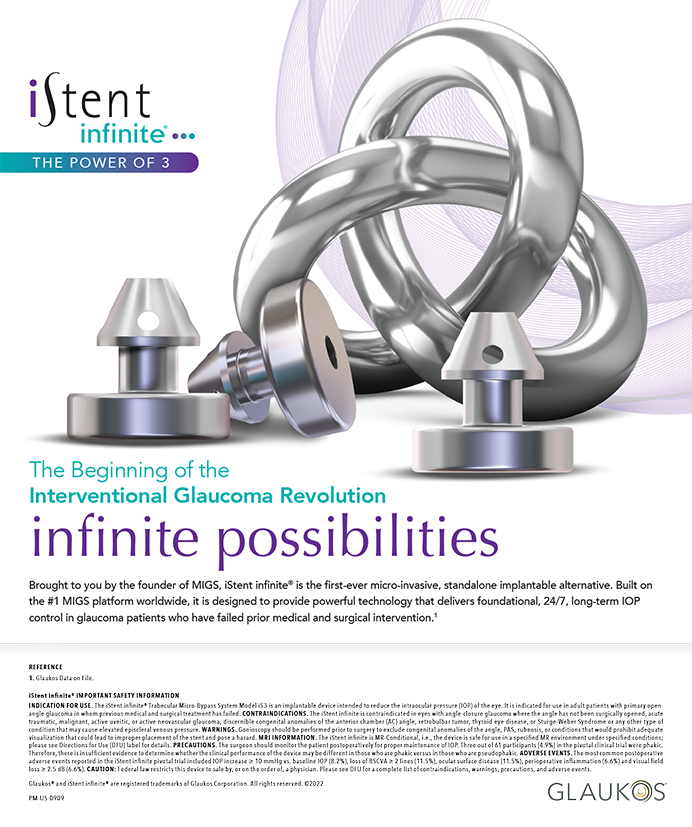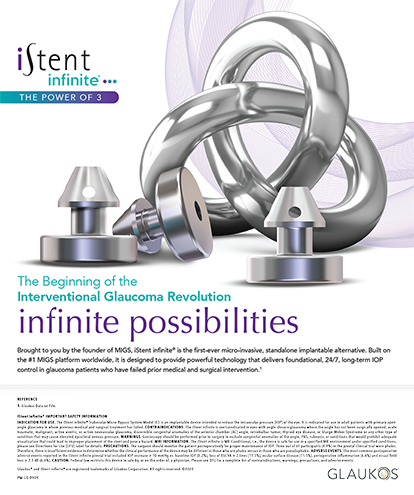In my experience, the incidence of micro- or macro-striae in the LASIK flap has decreased significantly over the past 5 years. I attribute this change to surgeons’ having successfully recognized, managed, and, finally, mostly prevented the occurrence of striae. The creation of the LASIK flap with the femtosecond laser and improved flap-edge design have also helped greatly.
Nonetheless, we surgeons occasionally encounter flap striae (Figure 1) during the immediate postoperative period in our own patients and occasionally in those seeking second opinions. In the latter group, the striae have often gone unrecognized and/or untreated, sometimes for several years. Here are my tips for preventing and treating striae.
PREVENTION IS THE BEST TREATMENT
Float and Stroke
Of course, the best treatment is prevention. I believe that the optimal strategy is to float and stroke the flap as if treating striae on postoperative day 1. That is, I irrigate and float the flap into position while stroking it with a very wet Merocel sponge (Medtronic ENT, Jacksonville, FL) away from the position of the hinge. I then manually squeeze the sponge a bit dryer and continue to stroke the flap directly away from the hinge.
After I am satisfied that the flap is relatively adherent in its horizontal or vertical orientation, as the case dictates, I then carefully stroke the tissue from the hinge—obliquely at first and then, finally, in an almost perpendicular motion to the flap’s original axis. I complete the entire procedure in 1 to 2 minutes. I pay greater attention to the final perpendicular smoothing/stroking in eyes with high amounts of myopia, as they have a much higher incidence of striae along the flap’s axis. I allow the flap to dry for 10 to 15 seconds in younger patients and for up to 1 minute in older patients.
Check the Gutter
Antibiotic, nonsteroidal anti-inflammatory, and lubricating drops are instilled, and the speculum is carefully removed. If I am using a laser with a slit lamp attached, I will pass the beam over the cornea to verify the gutter’s symmetry as well as to look for any foreign material. The patient is then taken to a separate slit lamp, where I again check the width and symmetry of the gutter to ensure that they are perfect. On the rare occasion when I am not happy with the symmetry of the gutter, the patient returns to the laser microscope, and I repeat the smoothing process.
Many surgeons use a much more minimalistic approach. They refloat the flap back into place. After one or two stokes away from the hinge with a wet Merocel sponge, they continue to wick the moisture out of the gutter with a dry sponge for 1 to 2 minutes while the flap settles. Although this procedure provides excellent results for some, I prefer the approach I described.
I instruct the patient and his or her companion on the proper technique for instilling postoperative drops. I tell the patient not to squeeze his or her eyelids and instruct him or her to wear shields for at least the first 3 nights and during naps.
WHEN TO IDENTIFY AND MANAGE STRIAE
Day 1
The best time to recognize and manage microstriae of the LASIK flap is on the day-1 examination. If the stria is far from the visual axis, and the patient has excellent vision and no complaints regarding differences in visual quality between his or her eyes, I leave the stria alone. If, on slit-lamp examination with a red reflex and high magnification, a wrinkle is seen in the visual axis, I treat it just as I described previously, taking an extra minute or so in the stroking and smoothing process (Figure 2). In such a case, I pay even more attention to the final stages of perpendicular stroking. If the epithelium is rough, I will use a soft contact lens. It is important to note that even though everything looks great with a symmetrical gutter, there may still appear to be striae, which will be gone on the next day’s examination.
Long-standing Striae
If striae are not recognized at the 1-day examination, my method can be tried for up to about 3 to 4 weeks postoperatively. After an extended period, more aggressive measures are needed.
For long-standing striae, I most often partially lift the flap at the slit lamp and then move the patient to the laser or another operating microscope. Next, I remove the central 4 to 5 mm of epithelium, lift the flap, and refloat it. Rather than Merocel-type sponges to stroke the flap into place, I use blunt, rounded forceps such as the Kelman-McPherson Tying Forceps to smooth the surface. My approach is the same as with the sponges, but I can apply much greater force with metal forceps to stretch the wrinkle(s), which have also been released by the epithelial removal. I continue this maneuver, smoothing for 7 or more minutes, verify the gutter’s symmetry, and then apply a bandage contact lens until the epithelial coverage is complete.
Instruments
Several instruments have been developed to help prevent and treat striae such as the Pineda LASIK Iron. The Johnston LASIK Flap Applanator can be used primarily or to manage striae.The Donnenfeld Striae Removal Spatula is heated, and both sides of the flap are “ironed” before its replacement.
CONCLUSION
When all else has failed, my final strategy is to lift the flap and suture it with an eight-bite antitorque suture. I then refloat the flap, place three cardinal 10–0 nylon sutures and a running eight-bite anti- torque 10–0 nylon suture, and remove the cardinal sutures. The patient uses a bandage lens for 1 to 2 days, and I remove the remaining suture after about 1 month. For me, this technique has always worked, but it is very time-consuming surgery.
Stephen F. Brint, MD, is an associate clinical professor of ophthalmology at Tulane University School of Medicine in New Orleans. He acknowl- edged no financial interest in the company or products mentioned herein. Dr. Brint may be reached at (504) 888-2020; brintmd@aol.com.


